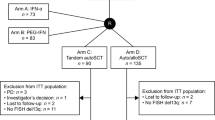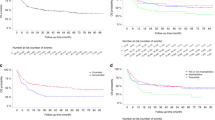Abstract
The role of allogeneic hematopoietic SCT (allo-HCT) in multiple myeloma (MM) remains controversial. A total of 58 patients received an allo-HCT (25 of them with myeloablative conditioning—allo-MAC—and 33 with reduced-intensity conditioning—allo-RIC) at our institution over a 28-year period. The CR rate for allo-MAC was 36%. The incidence of grade III–IV acute GVHD (aGVHD) and chronic GVHD (cGVHD) was 28% and 39%, respectively The TRM at any time was 60% and the main causes of death were aGVHD or infectious complications not directly related to GVHD. The estimated PFS and OS at 15 years were 8% and 15%, respectively. The CR rate with allo-RIC was 45%. The incidence of grade III–IV aGVHD and cGVHD were 24% and 41%, respectively. The TRM at any time was 33% and was mainly related to aGVHD. The estimated PFS and OS at 5 years were 22% and 38%, respectively. Despite its high TRM, a proportion of patients with high-risk myeloma (early relapse and newly diagnosed ultrahigh risk) may obtain long-term disease control with allo-HCT. New approaches aimed at decreasing the incidence of aGVHD, and consequently to decrease the TRM, are needed.
This is a preview of subscription content, access via your institution
Access options
Subscribe to this journal
Receive 12 print issues and online access
$259.00 per year
only $21.58 per issue
Buy this article
- Purchase on Springer Link
- Instant access to full article PDF
Prices may be subject to local taxes which are calculated during checkout



Similar content being viewed by others
References
Ludwig H, Bolejack V, Crowley J, Bladé J, San Miguel J, Kyle RA et al. Survival and years of life lost in different age cohorts of patients with multiple myeloma. J Clin Oncol 2010; 28: 1599–05.
Corradini P, Voena C, Tarella C, Astolfi M, Ladetto M, Palumbo A et al. Molecular and clinical remissions in multiple myeloma: role of autologous and allogeneic transplantation of hematopoietic cells. J Clin Oncol 1999; 17: 208–215.
Corradini P, Cavo M, Lokhorst H, Martinelli G, Terragna C, Majolino I et al. Molecular remission after myeloablative allogeneic stem cell transplantation predicts a better relapse-free survival in patients with multiple myeloma. Blood 2003; 102: 1927–1929.
Gahrton G, Tura S, Ljungman P, Bladé J, Brandt L, Cavo M et al. Prognostic factors in allogeneic bone marrow transplantation for multiple myeloma. J Clin Oncol 1995; 13: 1312–1322.
Bensinger WI, Bucker CD, Anasetti C, Clift R, Storb R, Barnett T et al. Allogeneic marrow transplantation for multiple myeloma: an analysis of risk factors on oucome. Blood 1996; 88: 2787–2793.
Gahrton G, Stevenson H, Cavo M, Apperley J, Bacigalupo A, Björkstrand B et al. Progress in allogeneic bone marrow and peripheral blood stem cell transplantation for multiple myeloma: a comparison between transplants performed 1983-93 and 1994-8 at European Group for Blood and Marrow Transplantation centre. Br J Haematol 2001; 113: 209–216.
Lokhorst H, Einsele H, Vesole D, Bruno B, San Miguel J, Pérez-Simón JA et al. International Myeloma Working Group consensus statement regarding the current status of allogeneic stem-cell transplantation for multiple myeloma. J Clin Oncol 2010; 28: 4521–4530.
Gahrton G, Iacobelli S, Björkstrand B, Hegnbart U, Gruber A, Greinix H et al. Autologous/reduced-intensity allogeneic stem cell transplantation vs autologous transplantation in multiple myeloma: long-term results of the EBMT-NMAM2000 study. Blood 2013; 121: 5055–5063.
Bladé J, Rosiñol L, Cibeira MT, Rovira M, Carreras E . Hematopoietic stem cell transplantation for multiple myeloma beyond 2010. Blood 2010; 115: 3655–3663.
Chng WJ, Dispenzieri A, Chim C-S, Fonseca R, Goldschmidt H, Lentzsch S et al. IMWG consensus on risk stratification in multiple myeloma. Leukemia 2014; 28: 269–277.
Moreau P, Cavo M, Sonneveld P, Rosiñol L, Attal M, Pezzi A et al. The combination of ISS 3, high LDH and t(4;14) and/or del (17p) identify a simple prognostic index for overall survival in patients treated with novel agents-based induction therapy and front-line autologous stem cell transplantation and allow the definition of a subgroup of patients at high-risk of early death from progressive disease. J Clin Oncol 2014; 32: 2173–2180.
Durie BG, Harousseau JL, San Miguel J, Bladé J, Barlogie B, Anderson K et al. International uniform response criteria for multiple myeloma. Leukemia 2006; 20: 1467–1473.
Kaplan EL, Meier P . Non-parametric estimation from incomplete observations. J Am Stat Assoc 1958; 53: 457–481.
Peto R, Pike MC . Conservation of the approximation sigma (O-E)2-E in the log-rank test for survival data or tumor incidence data. Biometrics 1971; 29: 579–584.
Rosiñol L, Pérez-Simón JA, Sureda A, de la Rubia J, de Arriba F, Lahuerta JJ et al. A prospective PETHEMA study of tandem autologous transplantation versus autograft followed by reduced-intensity conditioning allogeneic transplantation in newly diagnosed multiple myeloma. Blood 2008; 112: 3591–3593.
Caballero-Velázquez T, López-Corral L, Encinas C, Castilla-Llorente C, Martino R, Rosiñol L et al. Phase II clinical trial for the evaluation of bortezomib within the reduced intensity conditioning regimen (RIC) and post-allogeneic transplantation for high-risk myeloma patients. Br J Haematol 2013; 163: 474–482.
Gahrton G . Progress in allogeneic transplantation for multiple myeloma. Eur J Haematol 2010; 85: 279–289.
Crawley C, Iacobelly S, BJörkstrand B, Apperley JF, Niederwieser D, Gahrton G . Reduced-intensity conditioning for myeloma: lower nonrelapse mortality but higher relapse rated compared with myeloablative conditioning. Blood 2007; 109: 3588–3594.
Gahrton G, Iacobelly S, Bandini G, Björkstrand B, Corradini P, Crawley C et al. Peripheral blood or bone marrow cells in reduced-intensity or myeloablative conditioning allogeneic HLA identical sibling donor transplantation for multiple myeloma. Haematologica 2007; 92: 1513–1518.
Lokhorst HM, Segeren CM, Verdonck LF, van der Holt B, Raymakers R, van Oers MHJ et al. Partially T-cell depleted allogeneic stem-cell transplantation for first-line treatment of multiple myeloma: a prospective evaluation of patients treated in the phase III study HOVON 24 MM. J Clin Oncol 2003; 21: 1728–1733.
Rotta M, Storer BE, Sahebi F, Shizuru JA, Bruno B, Lange T et al. Long-term outcome of patients with multiple myeloma after autologous hematopoietic cell transplantation and nonmyeloablative allografting. Blood 2009; 113: 3383–3391.
Bruno B, Rotta M, Patriarca F, Mattei D, Allione B, Carnevale-Schianca F et al. Nonmyeloablative allografing for newly diagnosed multiple myeloma: the experience of the Gruppo Italiano Trapianti di Midollo. Blood 2009; 113: 3375–3382.
El-Cheikh J, Crocchhiolo R, Furst S, Stoppa AM, Ladaique P, Faucher C et al. Long-term outcome after allogeneic stem-cell transplantation with reduced-intensity conditioning in patients with multiple myeloma. Am J Hematol 2013; 88: 370–374.
Bensinger W, Rotta M, Storer B, Chauncey T, Holmberg L, Becker P et al. Allo-SCT for multiple myeloma: a review of outcomes at a single transplant center. Bone Marrow Transplant 2012; 47: 1312–1317.
Kumar S, Zhang MJ, Li P, Dispenzieri A, Milone GA, Lonial S et al. Trends in allogeneic stem cell transplantation for multiple myeloma: a g analysis. Blood 2011; 118: 1979–1988.
Gratwohl A . The EBMT risk score. Bone Marrow Transplant 2012; 47: 749–756.
Holtan SG, Pasquini M, Weisdorf DJ . Acute GvHD: a bench to bedside update. Blood 2014; 124: 363–367.
Solomon SR, Sizemore CA, Sanacore M, Zhang X, Brown S, Holland HK et al. Haploidentical transplantation using T cell replete peripheral blood stem cells and myeloablative conditioning in patients with high-risk hematologic malignancies who lack conventional donors is well tolerated and produces excellent relapse-free survival: results of a prospective phase II trial. Biol Blood Marrow Transplant 2012; 18: 1859–1866.
Fuchs EJ . Haploidentical transplantation for hematologic malignancies: where do we stand? Hematology 2012; 2012: 230–236.
Kröger N, Einsele H, Derigs G, Wandt H, Krüll A, Zander A . Long-term follow-up of an intensified myeloablative conditioning regimen with in vivo T cell depletion followed by allografting in patients with advanced multiple myeloma. Biol Blood Marrow Transplant 2010; 16: 861–864.
Acknowledgements
This work has been supported in part by grants from the Instituto de Salud Carlos III, Spanish Ministry of Health (FIS PI12/01093 and RD12/0036/0046, National Plan I+D+I supported by Instituto de Salud Carlos III and Fondo Europeo de Desarrollo Regional FEDER).
Author information
Authors and Affiliations
Corresponding author
Ethics declarations
Competing interests
The authors declare no conflict of interest.
Rights and permissions
About this article
Cite this article
Rosiñol, L., Jiménez, R., Rovira, M. et al. Allogeneic hematopoietic SCT in multiple myeloma: long-term results from a single institution. Bone Marrow Transplant 50, 658–662 (2015). https://doi.org/10.1038/bmt.2014.320
Received:
Revised:
Accepted:
Published:
Issue Date:
DOI: https://doi.org/10.1038/bmt.2014.320
This article is cited by
-
Allogeneic stem-cell transplantation for multiple myeloma: a systematic review and meta-analysis from 2007 to 2017
Cancer Cell International (2018)
-
How We Manage Patients with Plasmacytomas
Current Hematologic Malignancy Reports (2018)
-
Allogeneic stem cell transplantation and subsequent treatments as a comprehensive strategy for long-term survival of multiple myeloma patients
Bone Marrow Transplantation (2017)



